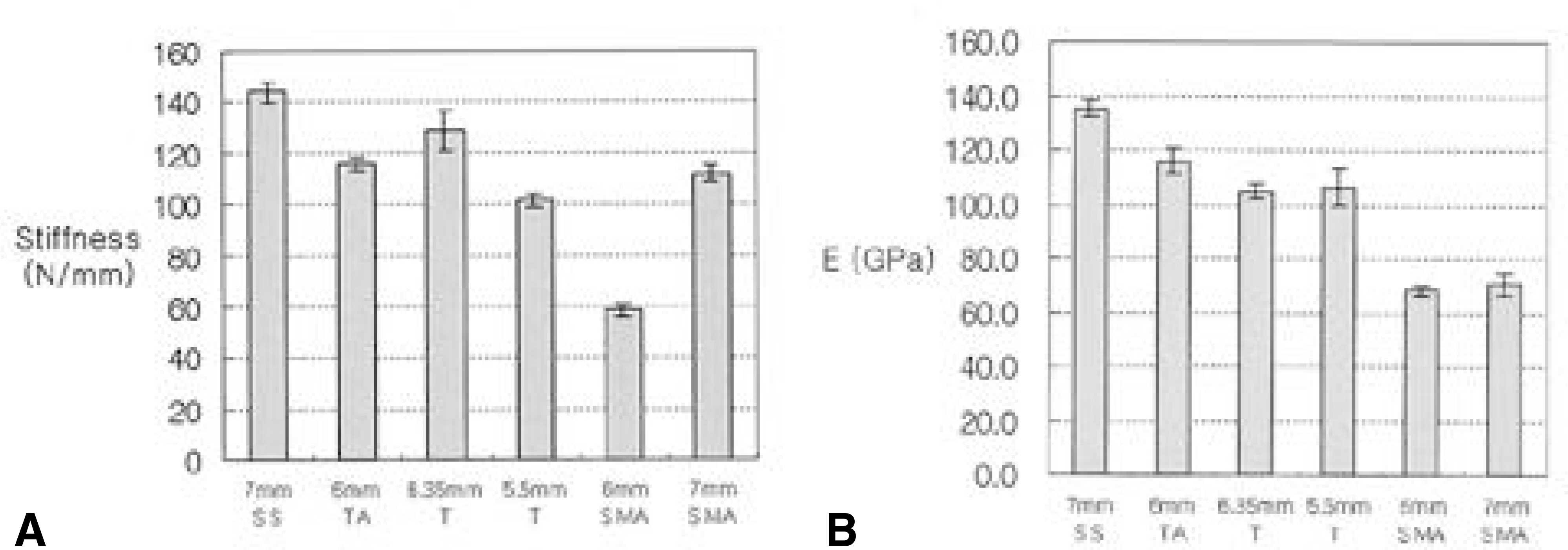J Korean Soc Spine Surg.
2001 Jun;8(2):130-135. 10.4184/jkss.2001.8.2.130.
Bending Stiffness of Rod in Pedicle Screw Systems
- Affiliations
-
- 1Seoul Spine Institute, Inje University Sanggye Paik Hospital, Department of Biomedical Engineering, Inje University, Korea. dragon@sanggyepaik.or.kr
- 2Department of Orthopaedic Surgery, Boramae Municipal Hospital, Korea.
- 3Department of Orthopaedic Surgery, Seonam University Namkwang Hospital, Korea.
- KMID: 2097752
- DOI: http://doi.org/10.4184/jkss.2001.8.2.130
Abstract
-
PURPOSE: To measure bending stiffness of rod in pedicle screw systems and identify the optimal rod for surgical correction of spinal deformities.
MATERIALS AND METHODS
Bending stiffness of six different rods -7 mm stainless steel, 6 mm titanium alloy, 6.35 mm titanium, 5.5 mm titanium, 6 mm Shape Memory Alloy after martensite temperature, 7 mm Shape Memory Alloy after martensite temperature were measured by MTS 858 Bionix test system according to the ASTM standards. The specimen number was 8 for each rod. Young's modulus of elasticity was calculated from load-displacement data.
RESULTS
Seven-mm stainless steel rod was stiffer than any other rods with bending stiffness of 143.7 +/- 3.8 N/mm, and also showed largest Young's modulus of elasticity of 135.1 +/- 3.0 GPa. Six-mm Shape Memory Alloy rod after martensite temperature was most flexible with bending stiffness of 58.1 +/- 2.8 N/mm, and showed smallest Young's modulus of elasticity of 68.0 +/-2.1 GPa. Seven-mm Shape Memory Alloy rod after martensite temperature was similar to the 6.35 mm titanium and 6 mm titanium alloy rod in bending stiffness and Young's modulus of elasticity.
CONCLUSION
Seven-mm stainless steel rod was the stiffest rod tested, which is necessary to improve correction rate and maintain achieved correction. However, the rod selection should be individulized since stiffer rod might increase the chance of acute failure. Seven-mm Shape Memory Alloy could be more useful in deformity correction than 6 mm Shape Memory Alloy since it was not only similar to other rods in stiffness but also had shape memory function which would be necessary to establish the desired position of the spine.
Keyword
MeSH Terms
Figure
Reference
-
1). Asher MA. Isola spinal instrumentation system for scoliosis. (in. Bridwell KH, Dewald RL, editors. The textbook of spinal surgery, 2nd ed. Philadelphia: Lippincott-Raven;p. 575. 1997. .).2). Carson WL, Redman RS, Richards KO. Bending stiffness and strength of VSP, Isola, C-D, TSRH, and luque longitudinal members to bone screw connection subcon -structs. Presented at the. Scoliosis Research Society;Annual meeting, Minneapolis, Minnesota, September. 1991.3). Cotrel Y, Dubousset J, Guillaumat M. New universal instrumentation in spinal surgery. Clin Orthop. 227:10–23. 1988.
Article4). Drummond D, Guadagni J, Keene JS, Breed A, Narechania R. Interspinous process segmental spinal instrumentation. J Ped Orthop. 4:397–404. 1984.
Article5). Harrington PR. Treatment of scoliosis. Correction and internal fixation by spine instrumentation. J Bone Joint Surg(Am). 44:591–610. 1962.6). Hibbs RA. A report of fifty-nine cases of scoliosis treated by the fusion operation. J Bone Joint Surg. 6:3–37. 1924.7). Hibbs RA, Risser JC, Ferguson AB. Scoliosis treated by the fusion operation. An end result study of three hundred and sixty cases. J Bone Joint Surg. 13:91–104. 1931.8). Johnston CE II, Ashman RB, Richards BS, Her-ring JA. TSRH universal spine instrumentation. (in. Bridwell KH, Dewald RL, editors. The textbook of spinal surgery,2nd ed. Philadelphia: Lippincott-Raven;p. 549. 1997. .).9). Kuo PP, Yang PJ, Zhang YF, Yang HB, Yu YF, Dai KR, Hong WQ, Ke MZ, Cai TD, Tao JC. The use of nickel-titanium alloy in orthopedic surgery in China, Orthopedics. 12:11–116. 1989.10). Luque ER. The anatomic basis and development of segmental spinal instrumentation. Spine. 7:256–259. 1982.
Article11). Moskowitz A, Moe JH, Winter RB, Binner H. Longterm follow up of scoliosis fusion. J Bone Joint Surg (Am). 62:364–376. 1980.12). Risser JC, Ferguson AB. Scoliosis. Its prognosis. J Bone Joint Surg (Am). 18:667. 1936.13). Suk SI, Lee CK, Kim WJ, Chung YJ, Song KY, Park YB. Segmenatl pedicle screw fixation in the treatment of thoracic idiopathic scoliosis. J of Korean Orthop. 30:49–58. 1995.
- Full Text Links
- Actions
-
Cited
- CITED
-
- Close
- Share
- Similar articles
-
- A Novel Blasted and Grooved Low Profile Pedicle Screw Able to Resist High Compression Bending Loads
- A Finite Element Analysis on the Effectiveness and Ideal Positions of the Tansfixators in Pedicle Screw Instrumentation
- Technical aspects of rod-insertion forceps (persuader) application in reducing construct failure after lumbar spine fusion surgery: a biomechanical cadaveric study in Germany
- Experimental Study for the Treatment of Long Bone Shaft Fracture with Non-reamed Flexible Intramedullary Nail
- The Mechanical Effect of Rod Contouring on Rod-Screw System Strength in Spine Fixation



